
Tyrannosaurus is a genus of large theropod dinosaur. The type species Tyrannosaurus rex, often shortened to T. rex or colloquially T-Rex, is one of the best represented theropods. It lived throughout what is now western North America, on what was then an island continent known as Laramidia. Tyrannosaurus had a much wider range than other tyrannosaurids. Fossils are found in a variety of rock formations dating to the latest Campanian-Maastrichtian ages of the Late Cretaceous period, 72.7 to 66 million years ago. It was the last known member of the tyrannosaurids and among the last non-avian dinosaurs to exist before the Cretaceous–Paleogene extinction event.

Tyrannosauridae is a family of coelurosaurian theropod dinosaurs that comprises two subfamilies containing up to thirteen genera, including the eponymous Tyrannosaurus. The exact number of genera is controversial, with some experts recognizing as few as three. All of these animals lived near the end of the Cretaceous Period and their fossils have been found only in North America and Asia.
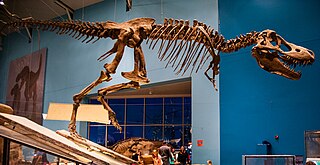
Tarbosaurus is a genus of tyrannosaurine theropod dinosaur that lived in Asia about 72-68 million years ago, during the Maastrichtian age at the end of the Late Cretaceous period, considered to contain a single known species: Tarbosaurus bataar. Fossils have been recovered from the Nemegt and Djadochta Formations of Mongolia, with more fragmentary remains found further afield in China.
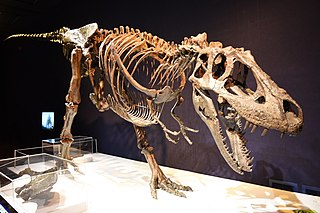
Daspletosaurus is a genus of tyrannosaurid dinosaur that lived in Laramidia between about 78 and 74.4 million years ago, during the Late Cretaceous Period. The genus Daspletosaurus contains three named species. Fossils of the earlier type species, D. torosus, have been found in Alberta, while fossils of a later species, D. horneri, have been found only in Montana. D. wilsoni has been suggested as an intermediate species between D. torosus and D. horneri that evolved through anagenesis, but this theory has been disputed by other researchers.

Dilong is a genus of basal tyrannosauroid dinosaur. The only species in this genus is Dilong paradoxus. It is from the Lower Cretaceous Yixian Formation near Lujiatun, Beipiao, in the western Liaoning province of China. It lived about 126 million years ago. This theropod discovery was significant as it was one of the first tyrannosauroids with fossil evidence of simple feathers.

Gorgosaurus is a genus of tyrannosaurid theropod dinosaur that lived in western North America during the Late Cretaceous Period (Campanian), between about 76.6 and 75.1 million years ago. Fossil remains have been found in the Canadian province of Alberta and the U.S. state of Montana. Paleontologists recognize only the type species, G. libratus, although other species have been erroneously referred to the genus.

Appalachiosaurus is a genus of tyrannosaurian theropod dinosaur from the Late Cretaceous period of what is now eastern North America. It was a basal member of the Eutyrannosauria clade meaning it was rather close in relation to the true tyrannosaurids such as Tyrannosaurus. Like most theropods, it was a bipedal predator. Only a juvenile skeleton has been found, representing an animal approximately 6.5 metres (21 ft) long and weighing 623 kilograms (1,373 lb), which indicates an adult would have been significantly larger.
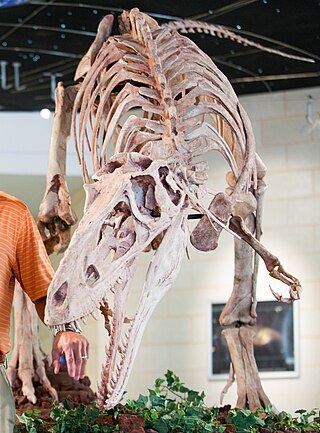
Alioramus is a genus of tyrannosaurid theropod dinosaurs from the Late Cretaceous period of Asia. It currently contains two species. The type species, A. remotus is known from a partial skull and three foot bones recovered from the Mongolian Nemegt Formation, which was deposited in a humid floodplain about 70 million years ago. These remains were named and described by Soviet paleontologist Sergei Kurzanov in 1976. A second species, A. altai, known from a much more complete skeleton also from the Nemegt Formation, was named and described by Stephen L. Brusatte and colleagues in 2009. Its relationships to other tyrannosaurid genera were at first unclear, with some evidence supporting a hypothesis that Alioramus was closely related to the contemporary species Tarbosaurus bataar. However, the discovery of Qianzhousaurus indicates that it belongs to a distinct branch of tyrannosaurs, namely the tribe Alioramini.
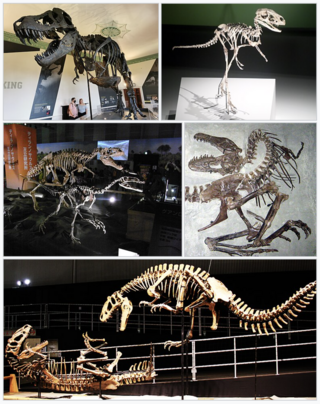
Tyrannosauroidea is a superfamily of coelurosaurian theropod dinosaurs that includes the family Tyrannosauridae as well as more basal relatives. Tyrannosauroids lived on the Laurasian supercontinent beginning in the Jurassic Period. By the end of the Cretaceous Period, tyrannosauroids were the dominant large predators in the Northern Hemisphere, culminating in the gigantic Tyrannosaurus. Fossils of tyrannosauroids have been recovered on what are now the continents of North America, Europe and Asia, with fragmentary remains possibly attributable to tyrannosaurs also known from South America and Australia.
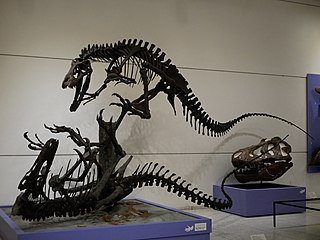
Dryptosaurus is a genus of basal eotyrannosaurian theropod dinosaur that lived on the island continent of Appalachia approximately 67 million years ago during the end of the Maastrichtian age of the Late Cretaceous period. Dryptosaurus was a large, bipedal, ground-dwelling carnivore that could grow up to 7.5 metres (25 ft) long and weigh up to 756–1,500 kilograms (1,667–3,307 lb). Although it is now largely unknown outside of academic circles, the famous 1897 painting of the genus by Charles R. Knight made Dryptosaurus one of the more widely known dinosaurs of its time, in spite of its poor fossil record. First described by Edward Drinker Cope in 1866 and later renamed by Othniel Charles Marsh in 1877, Dryptosaurus is among the first theropod dinosaurs ever known to science.

Tyrannosaurinae is one of the two extinct subfamilies of Tyrannosauridae, a family of coelurosaurian theropods that consists of at least three tribes and several genera. All fossils of these genera have been found in the Late Cretaceous deposits of western North America and east Asia. Compared to the related subfamily Albertosaurinae, tyrannosaurines overall are more robust and larger though the alioramins were gracile by comparison. This subfamily also includes the oldest known tyrannosaurid genus Lythronax as well as the youngest and most famous member of the group, Tyrannosaurus rex. There were at least 30 different species of tyrannosaurines.

Xiongguanlong is an extinct genus of tyrannosauroid theropod from the Early Cretaceous period of what is now China. The type and only species is X. baimoensis. The generic name comes from Jiayuguan City and the Mandarin word "long" which means dragon. The specific epithet, "baimoensis" is a latinization of the Mandarin word for "white ghost" in reference to one of the geological features of the type locality.

Sinotyrannus is a genus of large basal tyrannosauroid dinosaur, known from a single incomplete fossil specimen including a partial skull, from the Early Cretaceous Jiufotang Formation of Liaoning, China. Specifically, it is a member of the Proceratosauridae, a family that originated in the Jurassic whose members are known from Europe and Asia. Though it is not significantly younger than primitive tyrannosauroids such as Dilong, it is similar in size to later forms such as Tyrannosaurus. It was much larger than contemporary tyrannosauroids, reaching a total estimated length of 9–10 m (30–33 ft), and was the largest known theropod from the Jiufotang Formation. The type species, S. kazuoensis, was described by Ji et al. in 2009.

Proceratosauridae is a family or clade of tyrannosauroid theropod dinosaurs from the Middle Jurassic to the Early Cretaceous.

Bistahieversor, also known as the "Bisti Beast", is a genus of basal eutyrannosaurian theropod dinosaur. The genus contains only a single known species, B. sealeyi, described in 2010, from the Late Cretaceous of New Mexico. The holotype and a juvenile were found in the Hunter Wash Member of the Kirtland Formation, while other specimens came from the underlying Fossil Forest member of the Fruitland Formation. This dates Bistahieversor approximately 75.5 to 74.5 million years ago during the Campanian age, found in sediments spanning a million years.
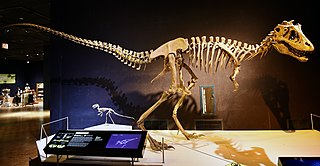
Lythronax is a genus of tyrannosaurid dinosaur that lived in North America around 81.9-81.5 million years ago during the Late Cretaceous period. The only known specimen was discovered in Utah in the Wahweap Formation of the Grand Staircase–Escalante National Monument in 2009, and it consists of a partial skull and skeleton. In 2013, it became the basis of the new genus and species Lythronax argestes; the generic name Lythronax means "gore king", and the specific name argestes originates from the Greek poet Homer's name for the wind from the southwest, in reference to the specimen's geographic provenance in North America.

Qianzhousaurus is a genus of tyrannosaurid dinosaur that lived in Asia during the Maastrichtian age of the Late Cretaceous period. There is currently only one species named, the type species Qianzhousaurus sinensis, which is a member of the tribe Alioramini and most closely related to Alioramus, the only other known alioramin.

This timeline of tyrannosaur research is a chronological listing of events in the history of paleontology focused on the tyrannosaurs, a group of predatory theropod dinosaurs that began as small, long-armed bird-like creatures with elaborate cranial ornamentation but achieved apex predator status during the Late Cretaceous as their arms shrank and body size expanded. Although formally trained scientists did not begin to study tyrannosaur fossils until the mid-19th century, these remains may have been discovered by Native Americans and interpreted through a mythological lens. The Montana Crow tradition about thunder birds with two claws on their feet may have been inspired by isolated tyrannosaurid forelimbs found locally. Other legends possibly inspired by tyrannosaur remains include Cheyenne stories about a mythical creature called the Ahke, and Delaware stories about smoking the bones of ancient monsters to have wishes granted.

Timurlengia is an extinct genus of tyrannosauroid theropod dinosaur found in Uzbekistan, in the Bissekty Formation in the Kyzylkum Desert, hailing from the Turonian age of the early Late Cretaceous. The type species is Timurlengia euotica.

Eutyrannosauria is a clade of tyrannosauroid theropods whose distribution has been found in what is now Asia and North America. The clade consists of an evolutionary grade of tyrannosaurs such as Appalachiosaurus, Dryptosaurus, and Bistahieversor which led up to the family Tyrannosauridae. The group was named in 2018 by Delcourt and Grillo in their paper about possible southern hemisphere tyrannosauroids and the phylogeography of tyrannosaurs.





































